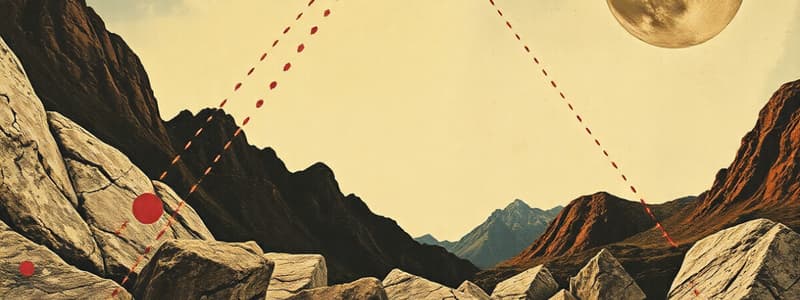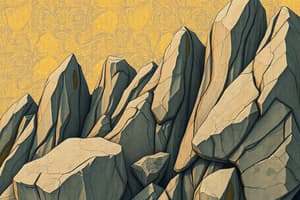Podcast
Questions and Answers
Which of the following processes is responsible for transforming sediment into sedimentary rock?
Which of the following processes is responsible for transforming sediment into sedimentary rock?
- Compaction and cementation (correct)
- Exposure to intense heat and pressure
- Weathering and erosion
- Melting and solidification
According to the law of superposition, how are the layers of strata arranged in undisturbed formations?
According to the law of superposition, how are the layers of strata arranged in undisturbed formations?
- The layers are randomly arranged.
- The youngest layers are on top. (correct)
- The youngest layers are in the middle.
- The oldest layers are on top.
What type of information can index fossils provide when found in different strata?
What type of information can index fossils provide when found in different strata?
- The temperature conditions of the strata.
- The exact location of the strata.
- The mineral composition of the strata.
- The relative age of the strata. (correct)
At which type of plate boundary would you most likely find a rift valley?
At which type of plate boundary would you most likely find a rift valley?
If a fault line cuts through several layers of sedimentary rock, what can be concluded about the fault line relative to the rock layers?
If a fault line cuts through several layers of sedimentary rock, what can be concluded about the fault line relative to the rock layers?
Which of the following geological features is commonly associated with transform plate boundaries?
Which of the following geological features is commonly associated with transform plate boundaries?
What is the primary process that occurs at mid-ocean ridges?
What is the primary process that occurs at mid-ocean ridges?
Why is oceanic crust generally denser than continental crust?
Why is oceanic crust generally denser than continental crust?
What is the primary difference between mechanical and chemical weathering?
What is the primary difference between mechanical and chemical weathering?
How does increased water volume and flow rate generally affect erosion?
How does increased water volume and flow rate generally affect erosion?
Flashcards
Rock Cycle
Rock Cycle
The continuous process of rocks forming, changing, and reforming on Earth.
Sediment
Sediment
Rock broken down into smaller pieces.
Lithification
Lithification
The process of sediments being compacted and cemented together to form sedimentary rock.
Strata
Strata
Signup and view all the flashcards
Law of Superposition
Law of Superposition
Signup and view all the flashcards
Law of Crosscutting Relationships
Law of Crosscutting Relationships
Signup and view all the flashcards
Index Fossils
Index Fossils
Signup and view all the flashcards
Lithosphere
Lithosphere
Signup and view all the flashcards
Subduction
Subduction
Signup and view all the flashcards
Weathering
Weathering
Signup and view all the flashcards
Study Notes
- The rock cycle illustrates how rocks on Earth change and form over time.
- Rocks pushed deep below the surface can melt into magma, which becomes lava when it reaches the surface through volcanic activity.
Igneous Rocks
- Igneous rocks are created as magma or lava cools and solidifies
Sedimentary Rocks
- Weathering breaks rocks into sediment, then erosion transports it, and deposition drops it in a new location.
- Sedimentary rocks form when sediment is compacted and cemented through lithification.
Metamorphic Rocks
- Metamorphic rocks are existing rocks altered by intense heat and pressure, and can be formed from igneous, sedimentary, or other metamorphic rocks.
- Sedimentary rocks typically occur in horizontal layers called strata.
- The law of superposition states that in undisturbed strata, younger layers are on top of older ones.
- Faults (cracks in the Earth’s crust) and intrusions (igneous rock within the crust) can cut through strata.
- The law of crosscutting relationships dictates the feature that cuts through another is younger.
- Index fossils, associated with a specific time, can indicate that strata formed around the same time.
- Geologists use strata to determine the relative order of major events in Earth’s history, represented by the geologic time scale.
Tectonic Plates
- The Earth’s lithosphere is divided into tectonic plates that move slowly over the asthenosphere.
- Tectonic plates move at an average of a few centimeters per year.
- Plate boundaries are the places where two plates meet.
- Divergent boundaries: plates move apart, form rift valleys and mid-ocean ridges.
- Convergent boundaries: plates move together, form mountains and trenches.
- Transform boundaries: plates move past each other, cause earthquakes.
- Complementary coastlines suggest that continents were once joined, providing evidence for plate motion.
Oceanic and Continental Plates
- Oceanic plates form the ocean floor, whereas continental plates form the continents.
- Oceanic crust is denser than continental crust.
- Trenches form when a denser oceanic plate is subducted under a less dense plate at a convergent boundary.
- Mid-ocean ridges form when two oceanic plates move apart at a divergent boundary.
- New oceanic crust is created at mid-ocean ridges, ages as it moves away, eventually reaching a trench and is destroyed.
Water and Earth's Surface
- Water movement shapes the Earth’s surface through weathering, erosion, and deposition.
- Weathering breaks down rocks and soil into sediment
- Mechanical weathering: Sediment created through physical means.
- Chemical weathering: Sediment creation through chemical reactions.
- Erosion: Water transports sediment.
- Water has greater erosional power with faster flow and more volume.
- Deposition/Sedimentation: Water drops sediment in a new location.
Studying That Suits You
Use AI to generate personalized quizzes and flashcards to suit your learning preferences.




